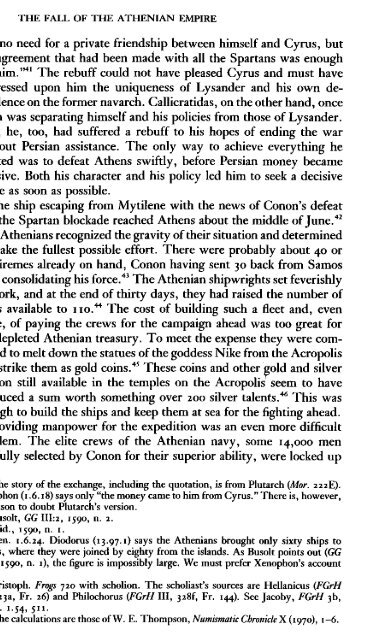The Fall of the Athenian Empire-(A New History of the Peloponnesian War) Donald Kagan - (1987)
MACEDONIA is GREECE and will always be GREECE- (if they are desperate to steal a name, Monkeydonkeys suits them just fine) ΚΑΤΩ Η ΣΥΓΚΥΒΕΡΝΗΣΗ ΤΩΝ ΠΡΟΔΟΤΩΝ!!! Strabo – “Geography” “There remain of Europe, first, Macedonia and the parts of Thrace that are contiguous to it and extend as far as Byzantium; secondly, Greece; and thirdly, the islands that are close by. Macedonia, of course, is a part of Greece, yet now, since I am following the nature and shape of the places geographically, I have decided to classify it apart from the rest of Greece and to join it with that part of Thrace which borders on it and extends as far as the mouth of the Euxine and the Propontis. Then, a little further on, Strabo mentions Cypsela and the Hebrus River, and also describes a sort of parallelogram in which the whole of Macedonia lies.” (Strab. 7.fragments.9) ΚΚΕ, ΚΝΕ, ΟΝΝΕΔ, ΑΓΟΡΑ,ΕΚΚΛΗΣΙΑ,ΝΕΑ,ΦΩΝΗ,ΦΕΚ,ΝΟΜΟΣ,LIFO,MACEDONIA, ALEXANDER, GREECE,IKEA
MACEDONIA is GREECE and will always be GREECE- (if they are desperate to steal a name, Monkeydonkeys suits them just fine)
ΚΑΤΩ Η ΣΥΓΚΥΒΕΡΝΗΣΗ ΤΩΝ ΠΡΟΔΟΤΩΝ!!!
Strabo – “Geography”
“There remain of Europe, first, Macedonia and the parts of Thrace that are contiguous to it and extend as far as Byzantium; secondly, Greece; and thirdly, the islands that are close by. Macedonia, of course, is a part of Greece, yet now, since I am following the nature and shape of the places geographically, I have decided to classify it apart from the rest of Greece and to join it with that part of Thrace which borders on it and extends as far as the mouth of the Euxine and the Propontis. Then, a little further on, Strabo mentions Cypsela and the Hebrus River, and also describes a sort of parallelogram in which the whole of Macedonia lies.”
(Strab. 7.fragments.9)
ΚΚΕ, ΚΝΕ, ΟΝΝΕΔ, ΑΓΟΡΑ,ΕΚΚΛΗΣΙΑ,ΝΕΑ,ΦΩΝΗ,ΦΕΚ,ΝΟΜΟΣ,LIFO,MACEDONIA, ALEXANDER, GREECE,IKEA
You also want an ePaper? Increase the reach of your titles
YUMPU automatically turns print PDFs into web optimized ePapers that Google loves.
THE BATTLE OF ARGINUSAE 341<br />
A<strong>the</strong>nian strategy, and saying little about <strong>the</strong> course <strong>of</strong> <strong>the</strong> fighting<br />
once <strong>the</strong> battle began. Diodorus' narrative, although taking better account<br />
<strong>of</strong> <strong>the</strong> geography and containing a few useful details, is generally<br />
implausible and full <strong>of</strong> rhetorical flourishes that contribute nothing to<br />
our understanding <strong>of</strong> <strong>the</strong> fighting. On this occasion, he seems to be<br />
following Ephorus at his rhetorical worst ra<strong>the</strong>r than <strong>the</strong> sober and<br />
judicious anonymous historian whose work has come to us on a papyrus<br />
from Oxyrhynchus. 56 Modern accounts have attempted to deal with<br />
<strong>the</strong> problems, to fill in <strong>the</strong> gaps, and to make sense <strong>of</strong> <strong>the</strong> battle, with<br />
greater or lesser degrees <strong>of</strong> success." None <strong>of</strong> <strong>the</strong>m, however, has fully<br />
accounted for <strong>the</strong> precision <strong>of</strong> some <strong>of</strong> <strong>the</strong> details provided by Xenophon,<br />
for <strong>the</strong> role played by <strong>the</strong> islands <strong>the</strong>mselves in <strong>the</strong> A<strong>the</strong>nian<br />
strategy, for <strong>the</strong> clues available about <strong>the</strong> course <strong>of</strong> <strong>the</strong> battle, and for<br />
<strong>the</strong> direction it took. <strong>The</strong> following description tries to give a fuller<br />
account.<br />
As <strong>the</strong> sun rose on <strong>the</strong> day <strong>of</strong> battle, Callicratidas' fleet began to<br />
row toward <strong>the</strong> east across <strong>the</strong> two miles <strong>of</strong> water that separated Cape<br />
Malea from <strong>the</strong> A<strong>the</strong>nian ships at <strong>the</strong> Arginusae Islands (see Map 1 1).<br />
56<br />
<strong>The</strong> main problem <strong>of</strong> Xenophon's account is that it <strong>of</strong>fers no explanation <strong>of</strong> why<br />
<strong>the</strong> A<strong>the</strong>nians were not outflanked and defeated by <strong>the</strong> Spartans, who were arrayed<br />
in a single line <strong>of</strong> 120 ships, while <strong>the</strong> A<strong>the</strong>nians were arranged in a formation in which<br />
<strong>the</strong>ir wings were formed in double lines, <strong>of</strong>fering a front line <strong>of</strong> only 30 ships on each<br />
wing joined by a center in single line <strong>of</strong> about 30, giving a front <strong>of</strong> only 90 ships. Since<br />
<strong>the</strong> Spartans are described as superior tactically, such an overlap ought to have given<br />
<strong>the</strong>m <strong>the</strong> victory, but Xenophon does not notice <strong>the</strong> problem. Diodorus recognizes <strong>the</strong><br />
A<strong>the</strong>nians' difficulty and says that <strong>the</strong>y used <strong>the</strong> islands as a means <strong>of</strong> extending <strong>the</strong>ir<br />
line. His explanation <strong>of</strong> <strong>the</strong> Spartans' response to <strong>the</strong> A<strong>the</strong>nian formation, however,<br />
is implausible, as we shall see, nor does he make clear <strong>the</strong> A<strong>the</strong>nian strategy. Once<br />
<strong>the</strong> fighting starts, his story is <strong>of</strong> even less value, containing statements that range from<br />
some contradicting his earlier ones, to o<strong>the</strong>rs that are highly implausible, to still o<strong>the</strong>rs<br />
that seem impossible. He calls most <strong>of</strong> <strong>the</strong> participants in <strong>the</strong> battle "experienced" and<br />
"<strong>the</strong> best" fighters (IJ-99-2), even though he has spoken <strong>of</strong> <strong>the</strong> emergency muster in<br />
which <strong>the</strong> A<strong>the</strong>nians were forced to cnroll anyone able to serve (IJ-97-I). He has<br />
Thrasyllus name <strong>the</strong> trierarch <strong>The</strong>ramcnes to a command, although <strong>the</strong>re were already<br />
eight A<strong>the</strong>nian generals at hand, and it is unclear where he would have found <strong>the</strong><br />
authority to do this. He has Callicratidas sink <strong>the</strong> ship <strong>of</strong> <strong>the</strong> A<strong>the</strong>nian general Lysias,<br />
although <strong>the</strong> former led <strong>the</strong> right wing <strong>of</strong> his fleet and <strong>the</strong> latter served at <strong>the</strong> opposite<br />
end <strong>of</strong> <strong>the</strong> battle, on <strong>the</strong> right wing <strong>of</strong> his fleet. His account <strong>of</strong> <strong>the</strong> preliminaries to <strong>the</strong><br />
battle is full <strong>of</strong> portents, dreams, and rhetoric. His narrative <strong>of</strong> Callicratidas' deeds in<br />
battle reads more like an epic ari.fteia than a historical description.<br />
57 <strong>The</strong> first thorough discussion was Grote's (VIII, I 70-1 73). L. F. Herbst (Die Schlacht<br />
bei den Arginusen [Hamburg, I 855]) made some useful contributions, although in several<br />
respects <strong>the</strong> work is inferior to Grote's. Probably <strong>the</strong> best discussion is Busolt's (GG<br />
Ill:2, I593-1596), although it contains a fundamental error about <strong>the</strong> A<strong>the</strong>nian order<br />
<strong>of</strong> battle.

















